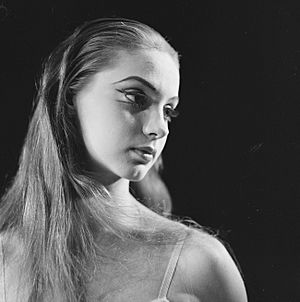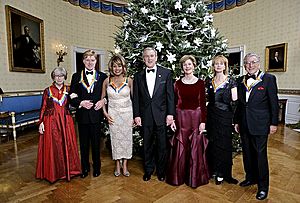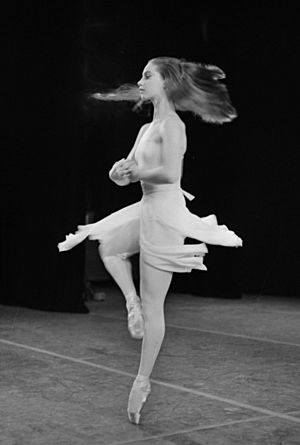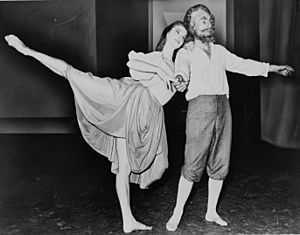Suzanne Farrell facts for kids
Quick facts for kids
Suzanne Farrell
|
|
|---|---|

Farrell in 1965
|
|
| Born |
Roberta Sue Ficker
August 16, 1945 Cincinnati, Ohio, United States
|
| Alma mater | School of American Ballet |
| Occupation | Ballerina; Masterclass Dance Teacher |
| Years active | 1960–1989; 1989-2017 |
| Known for | Dance Career; Dance Guru |
| Spouse(s) |
Paul Mejia
(m. 1969; div. 1997) |
| Honours | Kennedy Center Honors (2005) Presidential Medal of Freedom (2005) |
Suzanne Farrell, born on August 16, 1945, is a famous American ballerina. She also started her own dance company, the Suzanne Farrell Ballet. This company was based at the Kennedy Center in Washington, D.C.
Suzanne started learning ballet when she was a child in Cincinnati. In 1960, she earned a special scholarship. This allowed her to study at the School of American Ballet. She began dancing important roles in ballets in the early 1960s. She was a favorite dancer of the famous choreographer George Balanchine. In 1969, she left the New York City Ballet. She then moved to Brussels to dance for Maurice Béjart's Ballet of the 20th Century.
In 1975, Farrell returned to the United States. She worked with Balanchine until he passed away in 1983. She stopped performing ballet six years later. This was after she had hip surgery due to arthritis. Suzanne Farrell had a very long career as a ballet dancer. After she retired in 1989, she became a teacher. She taught at many ballet schools. She taught at the New York City Ballet until 1993. Since 2000, she has been a dance professor at Florida State University. In 2000, she also started her own company, the Suzanne Farrell Ballet. This company closed at the end of 2017.
Suzanne Farrell has received several special degrees. She is still very well-known and respected in the ballet world. She has been honored for her impact on dance with many awards. These include the Kennedy Center Honors and the Presidential Medal of Freedom. The Presidential Medal of Freedom is the highest award a civilian can receive in the United States. In 1987, she received the Golden Plate Award. This was from the American Academy of Achievement. She was also chosen to be part of the American Philosophical Society in 2016.
Contents
Early Life and Training
Suzanne Farrell was born Roberta Sue Ficker in Cincinnati, Ohio. She began her ballet training at the Cincinnati Conservatory of Music. In 1960, she was chosen to study at the School of American Ballet. This was thanks to a scholarship from the Ford Foundation. This school was founded by the famous choreographer George Balanchine.
In 1961, Suzanne joined the New York City Ballet (NYCB). She quickly became a special inspiration for Balanchine. He created many new ballets just for her.
A Career in Ballet
Dancing at the New York City Ballet
When Suzanne first joined NYCB, she was part of the corps de ballet. This means she danced in the group. But soon, she started dancing important solo roles. The first ballet made for her was Passage in 1963. It is now called Arcade.
Balanchine often paired her with dancer Jacques d'Amboise. They danced together in his ballet Meditation in December 1963. One of her most famous roles was Dulcinea. This was in Balanchine's Don Quixote. This ballet first appeared in May 1965. Many people thought Balanchine created this ballet as a special gift for Suzanne. He even danced the role of Don Quixote on the first night.
In 1968, Balanchine chose her to be the main dancer. This was for the "Diamonds" part of his ballet Jewels. Suzanne helped make many ballets even better. She pushed the limits of dance technique. In 1965, she was promoted to a principal dancer. This is the highest rank for a ballet dancer. Her first role as a principal dancer was in Agon. She danced this with Arthur Mitchell at the Paris Opera.
George Balanchine was very fond of Suzanne. He called her his "alabaster princess." He created many new dance parts for her. Suzanne said that learning from Balanchine was a team effort. She explained that when he was creating a ballet, ideas would just flow from him. He often couldn't do it the same way twice. So, she tried to understand exactly what he wanted the first time.
Suzanne Farrell married fellow dancer Paul Mejia in 1969. This caused some tension between her and Balanchine. Because of this, Suzanne and Paul decided to leave the company. Suzanne and Paul Mejia were married until 1997.
Suzanne and her husband joined a European dance company. It was called the Ballet of the 20th Century. This company was led by French choreographer Maurice Béjart in Brussels. With this company, she danced many main roles. Some of these roles were created just for her. She explored a very different style of dance there. During this time, she often danced with Argentine dancer Jorge Donn.
She eventually returned to Balanchine and the New York City Ballet in 1975. Balanchine continued to create new ballets for her. These included Chaconne, Mozartiana, and Tzigane. While living in New York City, she also appeared on the children's TV show Sesame Street in 1979-1980.
Suzanne Farrell's partnership with Balanchine lasted until he passed away in April 1983. His very last dance pieces were solos for her. She retired from the New York City Ballet on November 26, 1989. She was 44 years old. She performed in Sophisticated Lady and Vienna Waltzes. Suzanne had been away from the stage for three years because of her arthritis. She took her final bow with Lincoln Kirstein, who helped start the New York City Ballet.
Becoming a Dance Teacher
Dancing ballet at a high level is very demanding on the body. In 1983, Suzanne started to develop arthritis in her right hip. Despite trying different treatments for two years, her performing career was almost over by 1985. She struggled for several years but finally stopped performing in 1989.
After retiring from performing, she began teaching. She helped new generations of dancers learn Balanchine's ballets. She worked with dance companies all over the world. These included companies in Berlin, Vienna, the Paris Opera Ballet, the Kirov Ballet, and the Bolshoi Ballet. In 1993, the New York City Ballet ended her teaching position there.
In 2000, Suzanne Farrell began teaching in the Dance Department at Florida State University in Tallahassee, Florida.
Work at the Kennedy Center
In 2000, Suzanne Farrell started her own company. It was called the Suzanne Farrell Ballet. This company became a full dance company supported by the Kennedy Center. However, it closed down in 2017.

Suzanne Farrell's work with the Kennedy Center began in 1993 and 1994. The Center offered special ballet master classes with her. These classes were for ballet students aged 13 to 17. They gave students a chance to learn from one of the greatest ballerinas. Because of Suzanne's unique place in ballet, the Kennedy Center expanded the program in 1995. This helped more young people across America learn about the arts. Suzanne taught her students to make their movements more expressive. This yearly program of intense study grew into "Exploring Ballet with Suzanne Farrell."
In 1999, Suzanne Farrell received great praise. This was for her successful performances at the Kennedy Center. Her show was called Suzanne Farrell Stages the Masters of 20th-century Ballet. After its debut, her newly named company, the Suzanne Farrell Ballet, performed at the Kennedy Center in 2001 and 2002. They also went on a long tour. In 2005, Suzanne Farrell was one of five people to receive the Kennedy Center Honors. This is one of the highest awards for artistic achievement.
In 2007, the Suzanne Farrell Ballet started the Balanchine Preservation Initiative. This project aimed to bring back Balanchine's ballets that were rarely seen. As a result, ballets like Ragtime and Divertimento Brillante were recreated and performed.
The Kennedy Center announced in September 2016 that the company would close. This happened at the end of the 2017 performance season. The company had received good reviews and a budget of over $1 million each year. The President of the John F. Kennedy Center for the Performing Arts, Deborah Rutter, said the center was planning new expansion projects. Suzanne Farrell's future role at the center was not clear. However, Rutter said that Farrell would continue to be an "artistic partner."
See also
 In Spanish: Suzanne Farrell para niños
In Spanish: Suzanne Farrell para niños
- Women in dance



